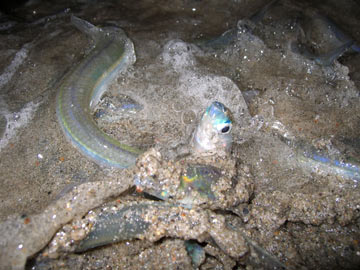They may not be as famous as the swallows of Capistrano, but some other seasonal visitors are returning to Southern California about now: grunion. The silvery fish pile up on sandy beaches by the thousands, where they lay their eggs before quickly washing back out to sea.
 Grunion during a spawning event. Credit: Julianne E. Steers / Grunion.org
Grunion during a spawning event. Credit: Julianne E. Steers / Grunion.org The California grunion is a small fish -- the typical adult is only five or six inches long. It spends most of its life in shallow waters not far from shore, from about San Francisco Bay down to northern Baja.
But beginning around the start of spring, grunion come ashore to spawn. It’s not a constant thing, though. Instead, it’s limited to a few nights each year.
The timing is critical. Grunion invade the beaches shortly after the highest tides after a full or new Moon. That allows them to travel as far ashore as possible, so that subsequent tides won’t wash away the eggs until it’s time for them to hatch.
A female drills herself into the soft sand, with only her head sticking out. She lays her eggs, and an entourage of males fertilize them. Then they all wiggle down the shore until a wave catches them.
When the waves uncover the eggs at the next high tide, they hatch and the newborns wash out to sea.
The grunion runs draw birds, cats, raccoons, and other animals. They draw people, too. During the latter half of the spawning season, beachgoers are allowed to catch the grunion -- but only with their bare hands. These restrictions protect the fish -- and ensure that some of California’s best-known visitors keep coming back.

